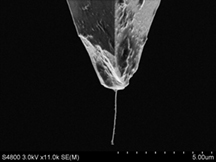Advances with atomic force microscope accuracy advance us on the path towards molecular manufacturing. However, this does not achieve 0.5 angstrom accuracy as some Scanning Electron Microscopes have. It does help more labs get greater accuracy.
Engineers at Purdue University have shown how researchers might better use tiny hollow fibers called “multi-walled carbon nanotubes” to more precisely measure structures and devices for electronics and other applications  Researchers attach the tubes to the ends of imaging instruments called atomic force microscopes. Because the tubes are long and slender, their shape is ideal for the emerging field of “nanometrology,” which is precisely measuring structures on the scale of nanometers, or billionths of a meter.
Researchers attach the tubes to the ends of imaging instruments called atomic force microscopes. Because the tubes are long and slender, their shape is ideal for the emerging field of “nanometrology,” which is precisely measuring structures on the scale of nanometers, or billionths of a meter.
Researchers use nanotubes as probes by inducing a vibration in a portion of the microscope assembly called a microcantilever.
“The microcantilever, which does all of the surface sensing, can be thought of as a very small oscillating diving board on which the silicon tip and nanotube are mounted to the free end,” Strus said.
As the microcantilever vibrates, the nanotube tip comes close to the surface but never actually touches the object being imaged. The closer the tip comes to the surface, the more powerful the attractive van der Waals’ forces become. The increasing attraction causes changes in the vibration pattern of the oscillating microcantilever, and the changing pattern is carefully monitored to reveal precise changes in contours on the surface of the object, yielding an image.
The same forces that enable the technology to work, however, also cause the sticking action of the probe. The vibrating tip sticks to the sides of the object being imaged, producing “artifacts,” or inaccuracies in the measurements and images.
The researchers showed precisely how artifacts are created by the sticking nanotubes, which are about 25 nanometers thick. The researchers also have shown how to avoid these artifacts by adjusting operating parameters of the microscope to prevent the tube from sticking.
The research was funded by the Centre for Nanomechatronics and Manufacturing in South Korea, and the work is associated with Purdue’s Birck Nanotechnology Center, which is part of Discovery Park, the university’s hub for interdisciplinary research.

Brian Wang is a Futurist Thought Leader and a popular Science blogger with 1 million readers per month. His blog Nextbigfuture.com is ranked #1 Science News Blog. It covers many disruptive technology and trends including Space, Robotics, Artificial Intelligence, Medicine, Anti-aging Biotechnology, and Nanotechnology.
Known for identifying cutting edge technologies, he is currently a Co-Founder of a startup and fundraiser for high potential early-stage companies. He is the Head of Research for Allocations for deep technology investments and an Angel Investor at Space Angels.
A frequent speaker at corporations, he has been a TEDx speaker, a Singularity University speaker and guest at numerous interviews for radio and podcasts. He is open to public speaking and advising engagements.


Comments are closed.